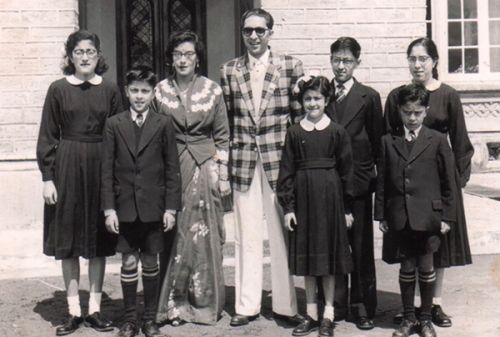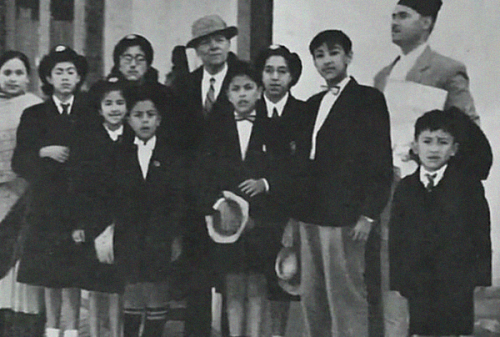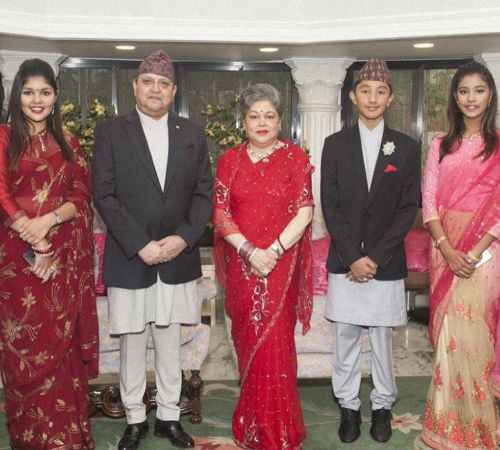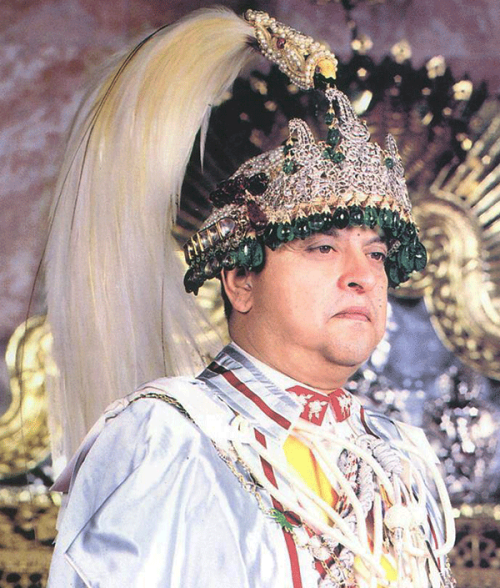
THE
BORN 7 JULY 1947

HM KING Gyanendra Bir
Bikram Shah Dev
His Majesty King Gyanendra Bir Bikram Shah Dev is the 12th Shah King of Nepal, and the world’s last Hindu monarch. He was born as the second son of Crown Prince Mahendra Bir Bikram Shah (later HM King Mahendra Bir Bikram Shah Dev) and Crown Princess Indra Rajya Laxmi Devi Shah. Although he was never expected to become King, he ascended the throne of Nepal twice — first in 1950 and then in 2001.
On 7 November 1950, at just 3 years old, His Royal Highness Prince Gyanendra was crowned the King of Nepal. He remained King for 2 months until 7 January 1951. On 4 June 2001, he ascended the throne again, thus becoming the only royal in the Shah dynasty to become King twice.
“It is the tradition of the Shah dynasty to carry out the affairs of the country in accordance with popular consensus and the people’s wishes. The wishes of our august brother…of guiding the Nepalese people towards a prosperous future through constitutional monarchy and multiparty democratic exercises will always remain a source of inspiration for all of us.”




EARLY LIFE
His Royal Highness Prince Gyanendra, the second son of then HRH Crown Prince Mahendra and his first wife, HRH Crown Princess Indra, was born in the old Narayanhiti Royal Palace in Kathmandu on 7 July 1947.
In 1950, when the Prince’s grandfather, His Majesty King Tribhuvan Bir Bikram Shah Dev along with the rest of the royal family fled to India as part of a royal plot, Prince Gyanendra, the only male member, was left behind. The then Prime Minister Mohan Shamsher crowned the Prince, a 3 year old toddler at the time, King, on 7 November 1950. He remained King for 2 months until 7 January 1951. He thus became the only royal in the Shah dynasty to become King twice.
HRH Prince Gyanendra received his early education at St. Joseph’s College in Darjeeling, India. After completing his higher secondary education from Darjeeling, he joined Patan Campus in Lalitpur, Nepal for his further education and graduated in 1969 from Tribhuvan University in Kathmandu, Nepal.

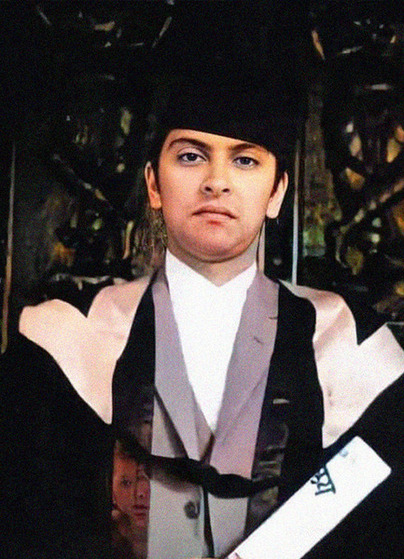
As the second-born son, HRH was never directly involved in politics or government activities during the reigns of his father, His Majesty King Mahendra, and his older brother, His Majesty King Birendra Bir Bikram Shah Dev. But as a member of the royal family, HRH Prince Gyanendra represented and supported Their Majesties by carrying out engagements in Nepal and on official tours overseas, and through his programme of charitable work and official duties.
Prince Gyanendra served as the chairman of the Advisory Committee during the coronation of his brother, HM King Birendra, in 1975. In the years that followed, he became a trusted adviser to His Majesty. He hosted royalties and dignitaries from around the world as part of the royal family and on behalf of the King.
In 1977, Prince Gyanendra hosted the Dutch Prince Bernhard and the elite WWF 1001 Club for several days in Chitwan as they launched gharial crocodiles into Narayani River with Peter Scott and discussed tiger distribution with Chuck McDougal. Soon after, the Prince also invited the Indian Prime Minister’s son Rajiv Gandhi for a stay in Chitwan. In the late 70s, when Prince Charles (now King Charles III of England) came to Nepal, Prince Gyanendra hosted the king and devised the “royal trek”, a route below Machhapuchhre mountain. In 1986, during Queen Elizabeth’s state visit, Prince Gyanendra escorted Prince Philip to Tiger Tops as part of his royal duties. He also hosted David Attenborough in Nirmal Niwas during the filming of a BBC nature series.
Until 1990, Prince Gyanendra attended National Day functions, organized by various Missions of friendly countries in Kathmandu. As a keen conservationist, he was active in several of His Majesty-led Government conservation efforts and environmental organizations. He led the Nepali delegation to the Third WWF International Conference held in Germany in 1973 and continued to serve on the World Wildlife Fund (WWF) international board. In 1982, he founded and also chaired King Mahendra Trust for Nature Conservation, now the National Trust for Nature Conservation (NTNC). He continued to chair the trust until 2001 when he ascended the throne.
He is also the founder member of 1001 Nature Conservation Fund, which was set up in 1986. He was also the Chairman of Lumbini Development Trust since 1986 but resigned from the Chairmanship in 1991. In the absence of His Majesty, the Prince acted as the Chairman of the Royal Regent Council and Royal Representative Council.
On behalf of His Majesty, the Prince also attended the last rites of King Jigme Dorji Wangchhuk of Bhutan in 1972. He also represented King Birendra at the wedding of the UK King, the then Prince Charles and Lady Diana Spencer in 1981. As part of his royal duties, he undertook official visits to the People’s Republic of China in 1975, India in 1973, Japan in 1986, the Netherlands and USA in 1987.
His conservation efforts took him to WWF functions around the world. In 1973, His Royal Highness led the Nepali delegation to the Third World Wildlife Fund (WWF) International Conference held in Germany and continued to serve on the WWF international board. As part of his role in the WWF, he was also directly involved in many programs to protect Nepal’s flora and fauna. In 1986, he traveled to Japan to attend the inauguration of the Japan Chapter of KMTNC. He also attended the 25th annual function of the WWF in Italy, followed by a WWF conference in San Francisco in 1976. The Prince also led the Nepali delegation to the Trustee and Council Meetings of the WWF, held in Demont, France in 1985. He also graced the annual function of the WWF in Kathmandu in 2000.
Other conferences graced by His Royal Highness included the International Youth Year Conference in 1985 and 15th Buddhist Religion Summit in 1986.
Throughout his reign and prior to it, His Majesty remained an active environmentalist and conservationist, closely involved with conservation activities in the country. He served on the World Wildlife Fund (WWF) international board, and founded and chaired King Mahendra Trust for Nature Conservation, now the National Trust for Nature Conservation (NTNC).
On 1 May 1970, HRH Prince Gyanendra married HRH Komal Rajya Laxmi Rana in Kathmandu as per Hindu traditions. Their Royal Highnesses went on to have 2 children: HRH Prince Paras Bir Bikram Shah, born on 30 December 1971, and HRH Princess Prearana Rajya Laxmi Devi Shah, born on 21 February 1978.
They are also blessed with 4 grandchildren. The marital union of their son HRH Prince Paras and his wife, HRH Princess Himani Rajya Laxmi Devi Shah have bore them 3 grandchildren: HRH Purnika Rajya Laxmi Devi Shah, HRH Hridayendra Bir Bikram Shah, and HRH Kritika Rajya Laxmi Devi Shah. They also have one grandson, Parthav Bahadur Singh, from their daughter’s marriage to Kumar Raj Bahadur Singh.
His Majesty has been a nature and literature enthusiast since his youth. This has been the foundation for his longstanding commitment to environmental issues and conservation efforts. A passionate environmentalist, he is well read on efforts made globally and locally on nature conservation. He reads volumes to stay up-to-date on environment and conservation topics till date.
As a young man, His Majesty was also interested in architecture and design. During the redesigning and reconstruction of the current structure of the Narayanhiti Royal Palace in the 1960s, the then HRH Prince Gyanendra was heavily invested in the project.
His Majesty is also known for his business acumen. As a Prince he ventured into different businesses and ran them efficiently. His ventures in the field of hospitality and tourism, hydropower, tea and tobacco continue to be flagship of their respective industries till date.
His Majesty is also a poet. He often pens under the name G. Shah. In August of 2022, a collection of his poems was released in a book titled “Dui Mutu Yeutai Bato” (Two Hearts One Path).
LIFE AS
4 JUNE 2001 – 28 MAY 2008

दुई हात जोड्ने भए, जोड नेपाललाई
आमालाई रोज, पाउने भए ईश्वरलाई
सुन-हीरा यहिँ खोज नगरेर बेर
आफूलाई पाउने भए नेपाललाई हेर ।
His Majesty King Gyanendra Bir Bikram Shah Dev ascended to the throne on 4 June 2001. A formal ascension ceremony was held at the historic Nasal Chowk of Hanuman Dhoka Palace, where Kesari Raj Pandey, senior priest of the royal household, crowned His Majesty amidst the chanting of Vedic scriptures. A contingent of the Royal Nepalese Army (RNA) presented a royal 101-gun salute to the new monarch. Unfortunately, he did not receive a traditional coronation in presence of foreign heads of states and dignitaries as the nation along with the Shah family were in the midst of a national tragedy.
One of the biggest national concerns during the reign of His Majesty King Gyanendra was the Maoist uprising. His Majesty regularly visited insurgency-affected mid-western and western development regions to acquire first-hand information about the security scenario. His visits as the King of Nepal and the Supreme Commander-in-Chief of the Royal Nepalese Army (RNA) boosted the morale of the security personnel deployed to combat terror and violence. His Majesty also relentlessly worked with the government to hold peace talks with the Maoist leaders.
Despite the growing national emergency, His Majesty did not lose sight of the needs of the world either. On 26 September 2001, he visited Birendra Peace Operations Training Centre at Panchkhal to watch the military exercises put on by a contingent of the First Division of the Devidatta battalion of the RNA who were due to leave for Sierra Leone on an UN peacekeeping mission. On 9 May 2002, he sent out a message addressing the battalion prior to their departure, wherein he commended the RNA for successfully fulfilling its responsibility as peacekeepers around the world.
During his time as the Sovereign, His Majesty made efforts to maintain a strong diplomatic relations with foreign nations, mainly Nepal’s two neighbors, India and China. In June 2002, Their Majesties the King and Queen embarked on a royal visit to India at the invitation of then President of India K.R. Narayanan. This was His Majesty’s first state visit since ascending to the throne. In July of the same year, Their Majesties paid a state visit to the People’s Republic of China on the invitation of the then Chinese President Jiang Zemin. They were accompanied by Her Royal Highness Princess Prearana Rajya Laxmi Shah. These state visits served to strengthen and further solidify Nepal’s long standing relationships with the two countries.
During his time as Monarch, His Majesty traveled abroad extensively on state visits to strengthen Nepal’s relations with nations worldwide. He also hosted foreign dignitaries and heads of state from many countries who came to Nepal to foster diplomatic ties.
The growing Maoist insurgency and the failure of leading political parties to successfully hold elections placed His Majesty in an increasingly difficult position. Still reeling from the shocking events of 2001 that took the lives of so many of his family members and the circumstances that unexpectedly thrust him onto the throne—a role for which he had never been directly prepared—he shouldered his responsibilities toward the Nepali people with determination.
In his attempt to stabilize the deteriorating situation, His Majesty dismissed three prime ministers in just three years. After peace talks with Maoist rebels failed to yield results, and following the advice of then-PM Girija Prasad Koirala, King Gyanendra took the extraordinary step of assuming complete control of the country in February 2005.
Though never formally trained in statecraft as his brother had been, HM King Gyanendra deeply understood the fundamental principle of monarchy: the happiness of his people transcended all else. By early 2008, recognizing the will of his people, His Majesty made the decision to step down, stating: “I go by the people’s choice and political preference and relinquish the crown… I do not want to rule the country over dead bodies… my own Nepali nationals…. The sons and daughters of mother Nepal.” This decision reflected the democratic values that both he and his late brother had supported, ultimately yielding to the wishes of the people despite his sincere efforts to lead a nation in crisis.
His Majesty, along with the rest of the Royal Family members, left the Narayanhiti Royal Palace on 11 June 2008. Although without a crown and the obligations that come with it, His Majesty continues to be a benevolent force for Nepal and her people. He regularly makes visits across the country to meet the people, engages in social and charitable activities, and works for their cause.
“I go by the people’s choice and political preference and relinquish the crown…I do not want to rule over people against their will…my own Nepali nationals…the sons and daughters of mother Nepal.”
Honours
2004

2001

1998

1996

1997

1995

1987

1987

1987

1986

1983

1983

1978

1975

1975

1974

1974

1970

1967

1956

1936

PATRONAGES

Patron-in-Chief for WWF

Chancellor at Tribhuvan University (TU)

Chancellor at Mahendra Sanskrit University (now Nepal Sanskrit University)

Patron of the Royal Nepal Academy (now Nepal Academy)

King Mahendra Trust for Nature Conservation (now Nepal Trust for Nature Conservation)

Patron of Lumbini Development Trust

Patron of Pashupati Area Development Trust (PADT)

Patron of Royal Nepal Academy of Science and Technology (now Nepal Academy of Science and Technology)

Patron of Britain-Nepal Society











